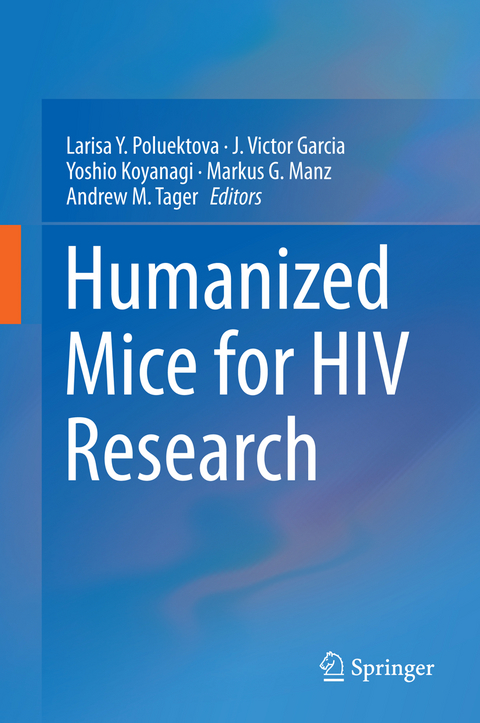
Humanized Mice for HIV Research
Springer-Verlag New York Inc.
978-1-4939-1654-2 (ISBN)
Humanized Mice for HIV Research provides a comprehensive presentation of the history, evolution, applications, and current state of the art of this unique animal model. An expansion of twelve review articles that were published in Humanized Mice by Springer in 2008 (Eds: Nomura T, Watanabe T, Habu S), this book expertly captures the outstanding progress that has been made in the development, improvement, implementation, and validation of humanized mouse models. The first two parts of this book cover the basics of human-to-mouse xenotransplantation biology, and provide critical information about human immune cell development and function based on individual models created from different immunodeficient strains of mice. The third and fourth parts investigate HIV-1 biology, including different routes of transmission, prevention, treatment, pathogenesis, and the development of adaptive immunity in humanized mice. The fifth part shows the broad applicability of humanized mice for therapeutic development, from long-acting antiretroviral combinations to genetic manipulations with human cells and cell-based approaches. The sixth part includes liver tissue engineering and the expansion of humanized mice for many other human cell-tropic pathogens.
Larisa Y. Poluektova, University of Nebraska Medical Center, Omaha, USA J. Victor Garcia, University of North Carolina at Chapel Hill, USA Yoshio Koyanagi, Kyoto University, Japan Markus G. Manz, University Hospital Zürich, Switzerland Andrew M. Tager, Massachusetts General Hospital and Ragon Institute of MGH, MIT and Harvard, USA).
Mamoru Ito's Vision for the Future of Humanized Mouse Models.- Part I. Mouse genetic background and human hematopoietic stem cells biology.- Humanized Mice as Models for Human Disease.- Role of mouse innate immunity in immunodeficient mice for xenotransplantation.- Mouse genetic background and human hematopoietic stem cells biology; tips for humanization.- Biology of Human Hematopoietic Stem Cell Xenotransplantation in Mice.- Impact of the mouse IL-2Rg chain on lymphoid tissue development and human reconstitution in immunodeficient mice.- BM hematopoietic niche occupancy defect of HSC in scid mice.- Improvement of human multilineage hematopoietic engraftment by cytokine knockin replacement in human-hemato-lymphoid system mice.- Part II. SECTION 2: Understanding of human immune cells development and function in mouse environment.- Cytokine species-specificity and humanized mice.- Human T cell biology in a mouse environment.- Thymic education of human T cells and regulatory T cell development in humanized mice.- Human B cell development in a mouse environment.- The analysis of the functions of human B and T cells in humanized NOG mice.- NK cell development in human immune system (HIS) mice and their role in HIV pathogenesis.- Maintenance and function of human CD8+ T cells and NK cells in humanized mice.- Phenotypical and functional properties of antigen-presenting cells derived from humanized mice.- Part III: Humanized mice for HIV-1 virus biology and pathogenesis. Is it possible to address?.- Humanized mouse versus non-human primate models of HIV-1 infection.- Host factor-mediated resistance to HIV-1 infection.- Vaginal and Rectal HIV Transmission in Humanized Mice.- Oral HIV-1 Transmission in BLT Humanized Mice.- Selective infection of CD4+ memory T cells.- Development and function of human CD4+CD25+FOXP3+ regulatory T cells in humanized mouse and HIV-1 infection.- Role of TLR signaling in HIV-1-induced adaptive immune activation.- Latent HIV-1 infection of resting CD4+ T cells: Testing approaches to overcome HIV latency.- Brain HIV-1 infection modeling in humanized mice.- Part IV. Humanized mice for HIV-1-specific adaptive cellular and humoral immune responses.- Antibody-based protection against HIV infection.- B-cell responses in humanized mice: the glass is half full.- Part V. Therapeutics developments for HIV-1.- Species similarities and differences in pharmacokinetics and distribution of antiretroviral drugs.- Anti-Retroviral Treatment Testing in HIV-Infected Humanized Mice.- Humanized Mice as a Platform for the Development of Long-Acting Nanoformulated Antiretroviral Therapy.- Targeted delivery of aptamers and siRNAs for HIV prevention and therapies in humanized mice.- Zinc finger nuclease editing of hematopoietic stem cells as an anti-HIV therapy.- Hematopoietic progenitor cell transduction by a unique short hairpin RNA to chemokine receptor 5.- Cell-based approaches for treating HIV infection.- A conditionally replicating human immunodeficiency virus in BRG-HIS mice.- Part VI. New models for other human-specific or human selective pathogens.- Dual reconstituted mice for hepatotropic pathogens.- Dengue viral pathogenesis and immune responses in humanized mice.- HIV-1 and TB: How Humanized Mice Can Help.- Epstein-Barr Virus Infection in Humanized Mice.- HTLV-1 infection of humanized NOD/SCID IL2 gc-/- and BALB/c-Rag2-/-gc-/- mouse models.- Plasmodium falciparum parasite development in humanized mice: liver and blood stages.- Part VII. New horizons in mouse humanization.- The Future is NOW for Humanized Mouse Models.
| Zusatzinfo | 45 Illustrations, color; 9 Illustrations, black and white; XXI, 538 p. 54 illus., 45 illus. in color. |
|---|---|
| Verlagsort | New York |
| Sprache | englisch |
| Maße | 155 x 235 mm |
| Themenwelt | Medizin / Pharmazie ► Medizinische Fachgebiete ► Mikrobiologie / Infektologie / Reisemedizin |
| Studium ► Querschnittsbereiche ► Infektiologie / Immunologie | |
| Naturwissenschaften ► Biologie ► Mikrobiologie / Immunologie | |
| Schlagworte | HIV • Humanized mice • Immune system function • Mouse-to-human xenotransplantation |
| ISBN-10 | 1-4939-1654-8 / 1493916548 |
| ISBN-13 | 978-1-4939-1654-2 / 9781493916542 |
| Zustand | Neuware |
| Haben Sie eine Frage zum Produkt? |
aus dem Bereich


